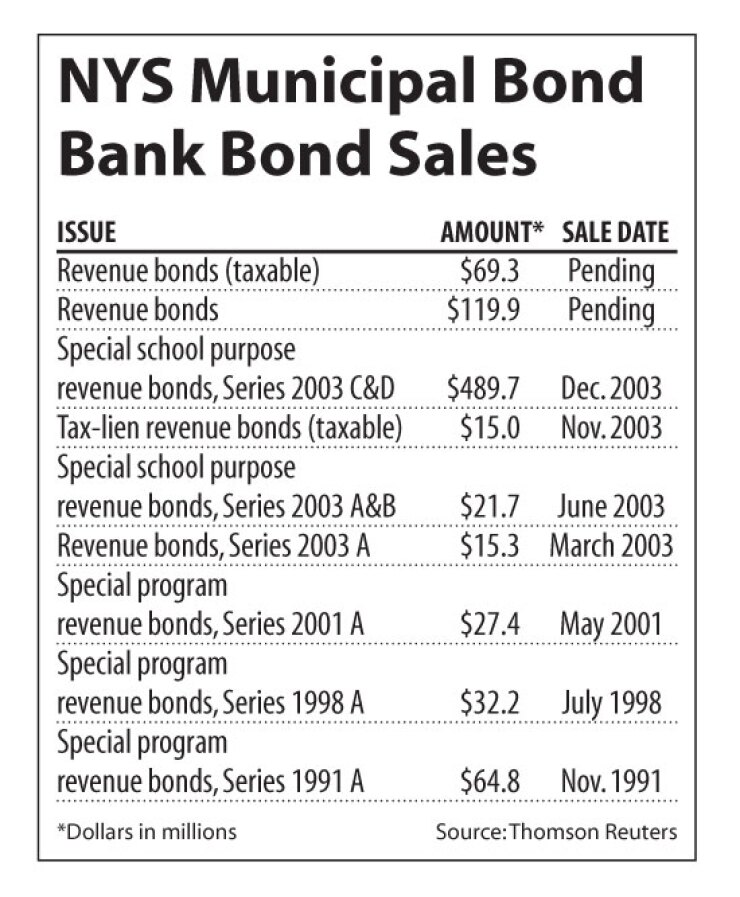
New York municipalities are pooling their bond issuance to take advantage of “super BABs” this week in what is expected to be the first of up to five deals.
The New York Municipal Bond Bank Agency expects to begin taking retail orders tomorrow on $189.3 million of bonds that will include a mix of tax-exempts, taxable Build America Bonds, and taxable Recovery Zone Economic Development bonds — called uper BABs because of their 45% interest subsidy. A one-day retail order will be followed by institutional pricing.
Jefferies & Co. is book-runner on the deal. Orrick Herrington & Sutcliffe LLP is bond counsel.
The federal government provides a 35% interest subsidy to BAB issuers and 45% subsidy to RZEDB issuers under the programs that were created by the American Recovery and Reinvestment Act of 2009.
The state program was created under legislation enacted last month. Municipalities that enter into the pooled financings sell general obligation bonds and assign their allocation of RZEDBs to the MBBA, said George Graham, senior vice president at MBBA. The issuer collects the subsidies and passes them on to the municipalities. The bonds sold by the municipalities to the issuer have the added security of an intercept of state aid.
“The confusion regarding the federal stimulus bond programs would have prevented many jurisdictions from taking advantage of these opportunities,” said Stephen Acquario, executive director of the New York State Association of Counties, which spearheaded the effort to get the legislation passed. “Of course these municipalities, large and small, could do it on their own ... It’s simply an option that’s out there.”
Although BABs have been widely popular, outside of New York City and large statewide issuers and authorities, few municipalities in the state have taken advantage of the tax-subsidy bonds. Since the first BABs deal in April, issuers have sold $61.27 billion of the bonds, accounting for 20% of all municipal bond issuance.
All counties in the state as well as municipal governments with populations of 100,000 or more got an allocation of RZEDBs, which can fund certain capital projects in areas designated as being economically distressed. New York City has the option to join a pooled financing, but deputy comptroller for public finance Carol Kostik said it has no plans to do so at this time. Treasury allocated New York a total of $370.1 million of the RZEDBs. There is no limit on BABs issuance.
“We’re looking for economies of scale,” Graham said. “We [also] expect enhanced marketability because of the New York State name.”
The bonds will be sold in three series that group similarly rated issuers. The issuer will market $50.4 million of Series 2009A bonds for Saratoga County and Brookhaven. Standard & Poor’s rates the series AA-plus with a stable outlook based on the municipalities’ ratings. Series 2009B will be sold at a par of $33.2 million and cover the A-plus rated Wayne and Warren counties. The largest series, $105.7 million of Series 2009C, will be sold for A-rated Rochester and Montgomery County.
Under state local finance law, most municipal governments have to sell their issues competitively, which means locking in their structure when they advertise the deal. But the MBBA doesn’t have to.
“For this program, we’re able to negotiate the sale of bonds and that’s an advantage because with the mix between tax-exempts and taxable BABs and RZEDBs, we can adjust [the structure], depending on the market the day we price, to get the best price for the municipal government,” Graham said.
The tax-exempt piece of the deals finances uses not eligible under ARRA and depending on the series, maturities range from 2010 to 2029. The BABs maturities range from 2013 to 2019, according to the preliminary official statement. The longest maturities were saved for the RZEDBs which carry the biggest subsidy and the greatest savings range from 2019 to 2035.
The MBBA expects to do three or four more pooled financings before the taxable bond programs expire at the end of 2010.





